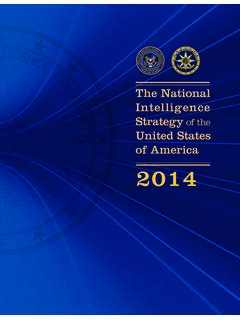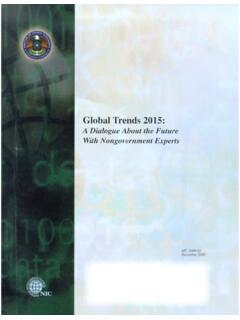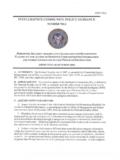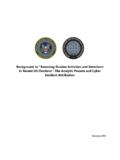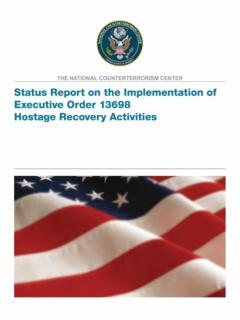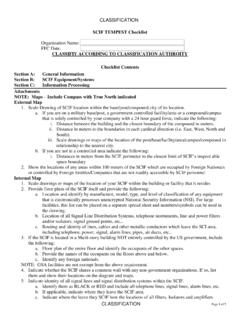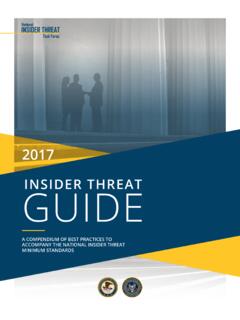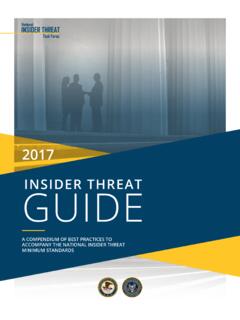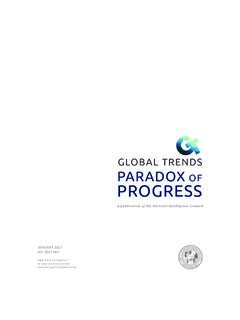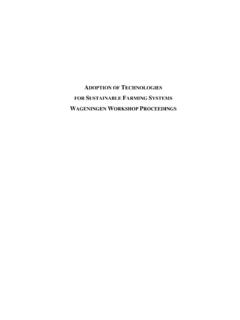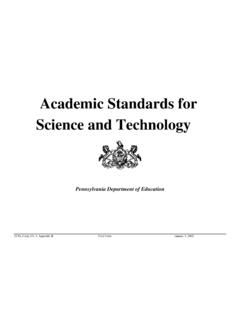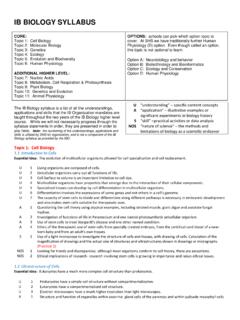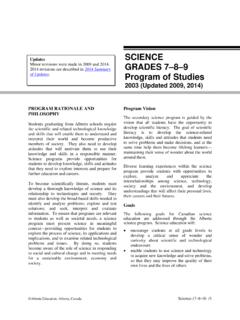Transcription of Overview - dni.gov
1 P. 1 OverviewGiven the unique opportunities and challenges posed by emerging technologies, the National Counterintelligence and Security Center (NCSC) today announced it is prioritizing its industry outreach efforts in a select few technology sectors where the stakes are potentially greatest for economic and national security. These sectors produce technologies that may determine whether America remains the world s leading superpower or is eclipsed by strategic competitors in the next few years. These sectors include, but are not limited to: As mandated by Congress, a core NCSC mission is to conduct counterintelligence (CI) outreach to the private sector, academic and research communities, as well as other external stakeholders to arm them with information about foreign intelligence threats to their organizations and ways to mitigate risk. NCSC, a center within the Office of the Director of National Intelligence responsible for leading and supporting the CI and security activities of the Government, routinely partners with other federal agencies in conducting outreach to outreach to emerging technology sectors is designed to raise awareness of nation-state threats and help these sectors protect their human talent and cutting-edge research, while not stifling their innovation and scientific collaboration.
2 NCSC seeks to safeguard these technological sectors and allow their growth and development. Challenges and Threats from Strategic leadership in emerging technology sectors faces growing challenges from strategic competitors who recognize the economic and military benefits of these technologies and have enacted comprehensive national strategies to achieve leadership in these According to the 2021 Annual Threat Assessment of the Intelligence Community, with a more level technology playing field anticipated in the future, new technological develop-ments will increasingly emerge from multiple countries and with less warning. While the democratization of such technologies can be beneficial, it can also be economically, militarily, and socially For this reason, advances in technologies such as computing, biotechnology , artificial intelligence, and manufacturing warrant extra attention to anticipate the trajectories of emerging technologies and understand their implications for QUANTUMSEMICONDUCTORSP.
3 2 The People s Republic of China (PRC) has a goal of achieving leadership in various emerging technology fields by The PRC ranks as the primary strategic competitor to the United States because it has a well-re-sourced and comprehensive strategy to acquire and use technology to advance its national goals, including technology transfers and intelligence gathering through its Military-Civil Fusion Policy and a National Intelligence Law requiring all Chinese entities to share technology and information with the PRC military, intelligence, and security Beijing is focused on technologies it deems critical to its economic and military future, including enabling technologies such as biotechnology , advanced computing, artificial intelligence, and help achieve its strategic goals, the PRC employs a wide variety of legal, quasi-legal, and illegal methods to acquire technology and know-how from the United States and other nations.
4 These methods include but are not limited to: Intelligence services Science and technology investments Academic collaboration Joint ventures Mergers and acquisitions Non-traditional collectors (including co-opted insiders) Talent recruitment programs Research partnerships Front companies Legal and regulatory actionsP. 3 Russia views the development of advanced science and technology (S&T) as a national security priority and is targeting advances through the employment of a variety of licit and illicit technology transfer mechanisms to support national-level efforts, including its military and intelligence These actions include using illicit procurement networks, seeking technology transfer through joint ventures with Western companies, and requiring access to source code from technology companies seeking to sell their products in Russia is increasingly looking to talent recruitment and international scientific collaborations to advance domestic research and development (R&D)
5 Efforts but resource constraints have forced it to focus indigenous R&D efforts on a few key technologies, such as military applications of Artificial s foreign technology acquisition toolkit includes but is not limited to: Intelligence services International scientific collaboration Academic collaboration Joint ventures and business partnerships Non-traditional collectors (including co-opted insiders) Talent recruitment Foreign investments Government-to-government agreements Legal and regulatory actionsP. 4 Key Emerging Technology SectorsArtificial Intelligence (AI) is the demonstration of cognition and creative problem solving by machines rather than humans or animals, ranging from narrow AI, designed to solve specific problems, to Artificial General Intelligence, a system that in the future may match or exceed a human being s understanding and learning The 2021 Final Report of the National Security Commission on Artificial Intelligence notes that AI is not one piece of hardware or software, but a constellation of technologies that requires talent, data, hardware, algorithms, applications, and : AI has rapidly improved the ability of computer systems to solve problems and perform tasks that would otherwise require human intelligence and AI is currently embedded in devices we use and interact with daily, such as smartphones, wireless routers, and cars.
6 And we routinely rely on AI-enriched applications, whether searching for a new restaurant, navigating traffic, or selecting a AI is also the quintessential dual-use technology. The ability of a machine to perceive, evaluate, and act more quickly and accurately than a human represents a competitive advantage in any field, civilian or military. AI technologies will be a source of enormous power for the companies and countries that harness : AI also expands the window of vulnerability for the United States. American technological dominance is under threat by strategic competitors like the PRC, which possesses the might, talent, and ambition to potentially surpass the as the world s leader in AI in the next decade if current trends do not AI also is deepening the threats posed by cyberattacks and disinformation campaigns that Russia, the PRC, and others are using to infiltrate our society, steal our data, and interfere in our America s military rivals are also integrating AI concepts and platforms to challenge Human talent, intellectual property, and R&D related to AI are targets of foreign nations seeking to enhance their own AI capabilities.
7 Ultimately, AI is dependent on data, and the ability of adversaries to deny access to or corrupt such data poses potential 5 Quantum Information Science and Technology, which includes quantum computing, networking, sensing, and metrology, leverages the fundamental properties of matter to generate new information technologies. For example, quantum computers can, in principle, use the unique properties of atoms and photons to solve certain types of problems exponentially faster than a conventional computer can. Over many decades, harnessing quantum aspects of nature has produced critical : Quantum information, science, and technology will bring new capabilities for both civilian and military purposes. Through developments in this field, the United States can improve its industrial base, create jobs, and provide economic and national security Prior examples of quantum-related technologies include semiconductor microelectronics, photonics, the global positioning system, and magnetic resonance imaging, underpinning significant parts of the national economy and defense Future scientific and technological discoveries in quantum may be even more impactful.
8 According to the White House Office of Science and Technology Policy, Government investments in quantum and more recent industry involvement have transformed this scientific field into a nascent pillar of the American R&D : Aside from their potential benefits, quantum technologies can also pose national security challenges. With further advancements in coming years, a large-scale quantum computer could potentially allow for the decryption of most commonly used cybersecurity protocols, putting at risk the infrastructure protecting today s economic and national security communications. In short, whoever wins the race for quantum computing supremacy could potentially compromise the communications of others. Without effective mitigation, the impact of adversarial use of a quantum computer could be devastating to national security systems and the nation, especially in cases where such information needs to be protected for many Other quantum technologies may have future national security impacts.
9 In the meantime, strategic competitors are recruiting America s human talent to advance their quantum programs. Some foreign nations spend substantially more than the United States on their quantum initiatives, putting them better positioned to recruit individuals. P. 6 The Bioeconomy can be defined as economic activity that is driven by research and innovation in biotechnology and is further enabled by the convergence of the life sciences and data sciences ( , informatics, high-perfor-mance/quantum computing, and telecommunications).Benefits: Americans everyday lives benefit from the bioeconomy in terms of the food they eat, the health care they receive, the quality of their environment, and the fuels, materials, and products they consume. The bioeconomy is poised to make even larger contributions in all of these sectors and expand into additional areas as The bioeconomy provides a means of developing new and innovative products and achieving such benefits as lower carbon consumption and improved health care solutions.
10 It also has opened new avenues for innovation, job creation, and economic : The powerful technologies harnessed by the bioeconomy also can lead to national security and economic vulnerabilities. For example, biotechnology can be misused to create virulent pathogens that can target our food supply or even the human population. Genomic technology used to design disease therapies tailored to an individual also can be used to identify genetic vulnerabilities in a population. Large genetic databases that allow people s ancestry to be revealed and crimes to be solved also can be misused for surveillance and societal During the past decade, moreover, competition in the global bioeconomy has intensified. Foreign nations have stolen critical intellectual property, research, and know-how from the bioeconomy. And, as a result of some countries policies, an asymmetry exists in the way information is shared, whereby the ability of researchers to access and use such information is Compounding the security challenges is that many existing legal frameworks focus on protecting finished intellectual property or licensed/patented products.
